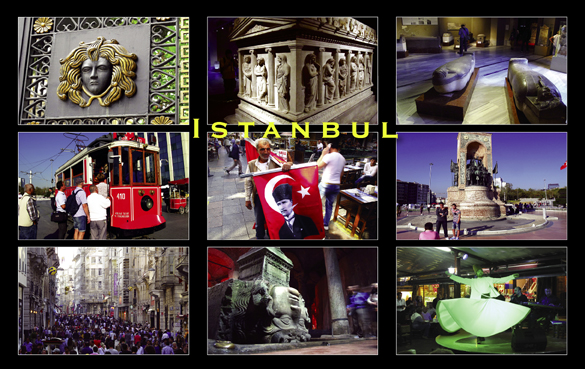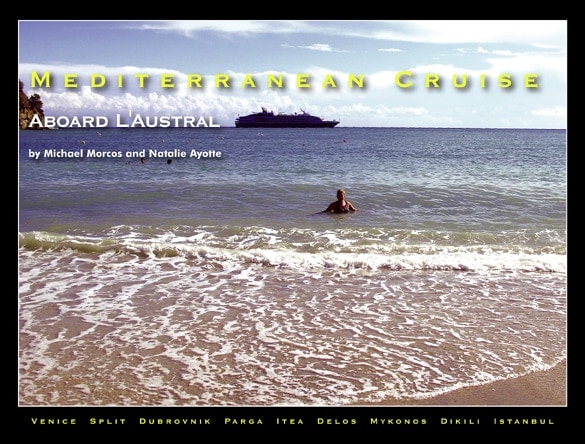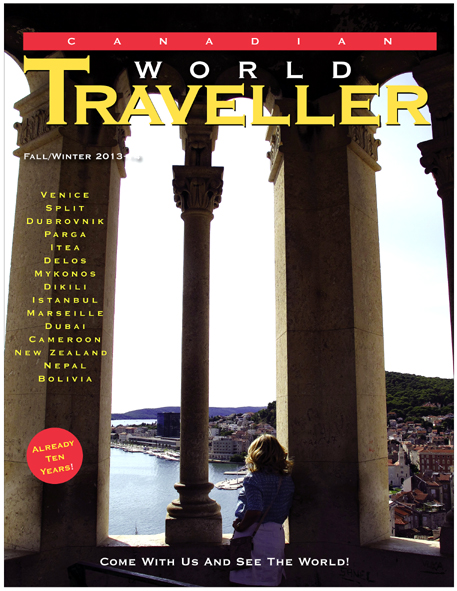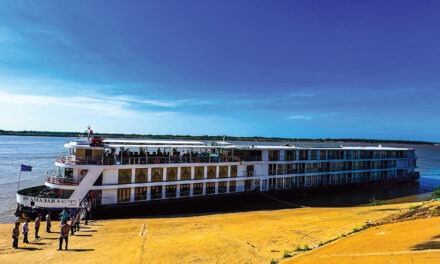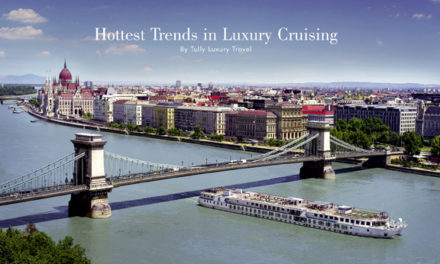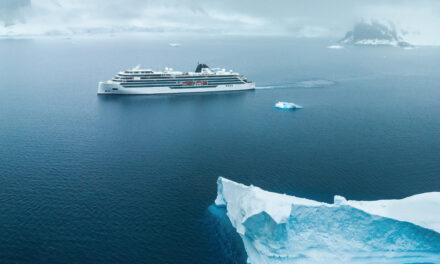Mediterranean Cruise
Aboard L’Austral
by Michael Morcos and Natalie Ayotte
As the European summer draws to a close, the thoughts of many living on the old continent are of the back to school rush and the looming Christmas period. The crowds from around the world disperse, and while most of Europe begins to wrap up the southern countries enjoy a late burst of sun like nowhere else. The Mediterranean shimmers to a different light whilst the shadows of the picturesque houses along the Adriatic lean further and further away. Romantic is Europe’s forte, and Southern Europe in September and October is perfect getaway, where one can witness the slow pace of the continent that few tourists see.
You can travel across Europe by any means without much difficulties – train passes are reasonably priced and even road trips are made easier by the lack of borders between countries. Therefore Europe overland has been the rage for some time. To try something different, I chose the sea option.
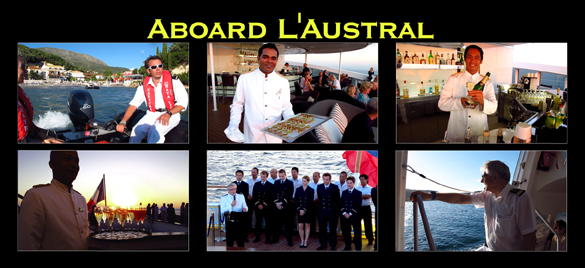
Cruise liners have been shaking up their packages since the drop in figures after the 2008/2009 recession, and Compagnie du Ponant – based in Marseille, France – is now running a four strong fleet of luxury vessels which are much more resembling to a luxury yacht than a cruise ship. Founded in 1988, the cruise line company is now worldwide and has been the talk of the industry in Europe after significantly raising the standards of what one can expect.
The company mainly caters to the French and European market, although there is a growing interest from North America and beyond. French cuisine is the name of game, and Compagnie du Ponet sure know how to do this well. The array of options on the menu made me wish I had more time, as some of the dishes just provoke a second and third tasting throughout the trip. The atmosphere is relaxed and caters for those looking for space, personalized service, and socializing only when desired. Pricing is all inclusive, and includes all meals, open bars and fully stocked mini bars, 24 hour room service and all port charges and taxes, allowing the company to remove any added inconveniences that may arise when one simply just wants to enjoy. Cruises depart from various cities throughout Europe, and I was embarking from one of the continents classics.
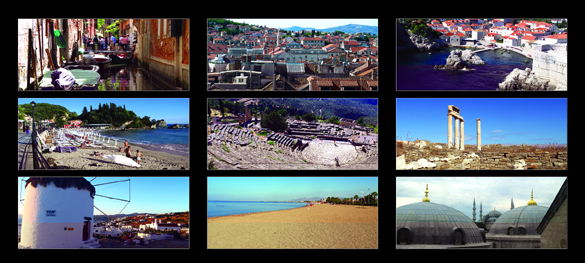
Venice Split Dubrovnik Parga Itea Delos Mykonos Dikili Istanbul
Window Shopping in Venice
Our boat departed from northern Italy in beautiful Venice, where we arrived four days prior in order to wander the maze-like streets with little rush. Venice is a charm and always entices me back, and September is an ideal time to visit. Our bags were already packed and ready for the cruise, so while Venice wasn’t about stocking up on souvenirs before our trip had even begun, one simply can’t help but peer through the windows of the endless boutique stores that squeeze themselves into the narrow alleys and streets wherever they can fit. Stores offer Venetian masks, hand printed fabrics, glass beads and Venetian handicrafts ranging from miniature gondolas to replicas of the Piazza San Marco – I had accidently made my stay in Venice a window shopping expedition, with sudden space in the suitcase for one or two memories to be taken away.
In Venice it’s always a good idea to familiarize yourself with the Grand Canal and Piazza San Marco (St. Mark’s Square). The maze of streets in between can become confusing, however there are arrows on most street corners which guide you to at least one of the two locations mentioned.
After a night’s sleep we took a Gondola ride to soak up the magic. I requested that the Gondolier steer us through the sleepy, narrow streets instead of galloping along the Grand Canal, which is beautiful from north to south, but can become a waste unless a turn is made into the alleys.
From there on Venice is just magic, and remarkably quiet. One of my biggest advices for Venice is – after seeing the main touristic sites – simply allowing yourself to get lost. Take a map – or maybe not – and simply wander deeper and deeper into the streets, away from the Grand Canal and Main Square, and enjoy Venice to yourself. Even during the high summer season, you can find staggeringly quiet corners of the city, where echoing footsteps can be heard amongst the gentle splashes of water against the old houses.
After enjoying Venice in a different light, it was time to set off..
Air France has daily flights to Venice from France and departures from major Canadian cities. Air France and the SkyTeam Alliance offer 15,000 daily flights to 1,024 destinations in 178 countries and connections from the best hubs in the world. www.airfrance.com

Croatia – Split First Port of Call
With a population of less than 200,000, one of my first questions after discovering the tranquil seaside city of Split was why more people hadn’t made Croatia’s second largest city a more permanent base. With a wonderful climate reaching almost 3,000 sunlight hours a year, locals have long hailed Split as the world’s most beautiful city. Along with the welcoming weather, history buffs will be thrilled by what remains of the past eras, as Pharaonic Egypt, Ancient Rome, the Renaissance and the present exist side by side in perfect harmony.
Arriving to the city by water is majestic in its own right, but arriving in the late summer made disembarking even more special. I was pleasantly surprised by Split from the first minute. A museum in itself, the city is a UNESCO World Heritage site and home to Diocletian’s famous Palace. Built in the 4th century AD, the historic center of Split is built around the ruins of this Roman Palace. Wander around the narrow streets within the ruins, follow the signs at the end of each passageway and mix with the locals in the courtyards – some of them packed, others deserted and mysterious, while narrow streets leading into the shadows invite the daring. Peristil Square is the main square of the palace, and can be used as a meeting point to gather ones bearings.
Diocletian’s famous Palace serves as the heartbeat of Split, however away from this there were a few treasures to take in before leaving. Split is home to two original Egyptian sphinxes, imported from Egypt by Diocletian. One is housed in the aforementioned main square of the palace, while the other can be found in St. John’s Church.
Riva is the city’s main promenade, and for those looking for a taste of nature, head to the hill of Marjan, situated to the west of the city. Perfect for relaxed walking, jogging and biking, Marjan means ‘the lungs of the city’ and building work in the area is strictly forbidden. A panoramic view of the city waits at the hills moderate summit of 174 m.
Split is perfectly sized for boat cruises. Of course, one could spend many days here exploring, however the city is small enough to be taken in quickly. What is for certain is that the taste I got for Split has made ensured I will be returning with a more open schedule in the future.
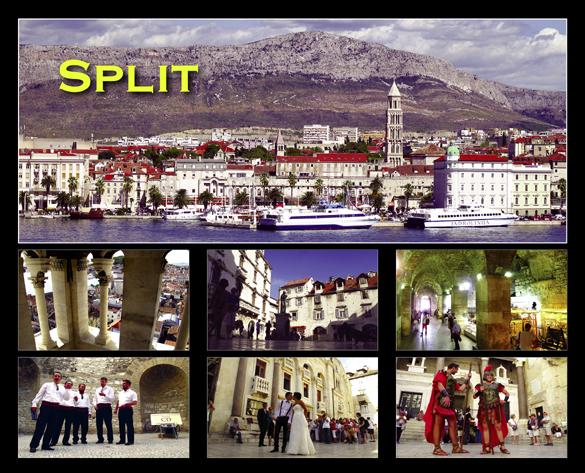
Croatia – Dubrovnik The Pearl of the Adriatic
After a calm, overnight sailing a little further down the Adriatic, we arrived in the aesthetically pleasing city of Dubrovnik. Known throughout the world as the Pearl of the Adriatic, this walled city built on a rock has preserved its Gothic, Renaissance and Baroque heritage despite a damaging earthquake in 1667. Palaces, monuments and white stone churches take you on a journey through the various periods and are in perfect harmony. Long considered as a rival to Venice, traces of its illustrious past are to be found throughout the city, which is also a UNESCO World Heritage site.
I had a Sunday morning and afternoon to discover some of the city’s highlights, and began by exploring the city walls on foot, said to be the finest preserved city walls in the world. Built in 13th and 14th centuries to protect the city from attacks, walking amongst the walls – some of which are 25 m high – to the Minčeta Tower will prove to be a highlight of your trip.
Pile gate – the city’s wonderfully crafted entrance point – is where many start their exploration of the city, and crossing the drawbridge is a must for any visitor. Other points of interest should include a visit to the Franciscan Monastery and Museum and the 15th century Rector’s Palace.
I finished the day by heading up to Mt Srđ by cable car, where one can gaze in awe at a city blessed with remarkable beauty, both naturally and man-made. Viewing the early evening sun over Adriatic is a perfect way to end any day in one of Europe’s most beautiful cities.
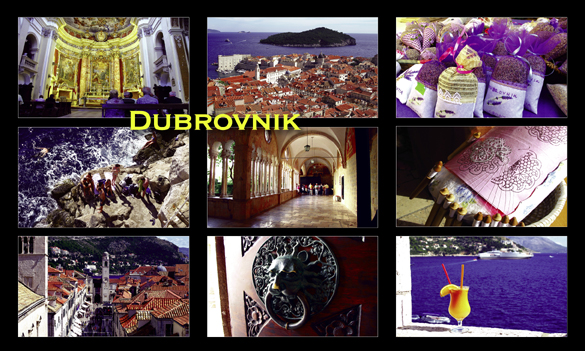
Greece – The Unspoiled City of Parga
In the heart of a sheltered cove on the north western shores of Greece in the Epirus province, Parga was Venetian from the 15th to the end of the 18th century. During that period it belonged to Ali Pacha, a high official of Suleiman the Magnificent. Its imposing Venetian citadel built on a steep rocky promontory dominates the town, the port and the sweet smelling pines which surround it. Today it is a lovely seaside resort, crammed between mountains and shimmering waters and buzzing with high spirited locals who dock their boats along the bay whilst the seaside bars, tavernas and restaurants are awash with conversation and local music.
With tourism only just beginning to spread to Parga, the city feels completely Greek, the locals are friendlier and crowds are not a problem – yet.
With an afternoon to discover the city’s charming cobbled streets, I set off to the Ali Pasha Castle, which is a short 20 minute bus ride from the town center. The views from the top are worth the ride and the ruins of the castle are there to be explored. Those who have no problems with walking can hike back down to the center, which is all downhill and is just 4 km long. Nearby, the old Greek Fortress, built in the 14th century is also worth a visit. The fortress guarantees spectacular vistas of the city and the nearby beaches, whilst keeping in touch with the history of the region.
Back in the city, Parga is buzzing with local life, and I spent an hour with some appetizers admiring the view of the waters, before boarding our ship for the night. The nearby beaches of Valtos and Lichnos are magnificent, almost to the point where they are underplayed and under promoted, however the city is still catering for locals only who don’t need signs and tour guides – something the modern traveler takes great pride in discovering.
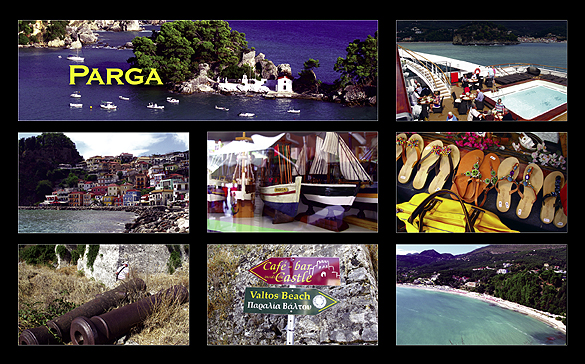
Greece – Itea Between the Sea and mountains
Located at the base of Mount Parnassos, the quiet seaside town of Itea is one of those towns that has convenient access to both sea and mountains. A local hinted that during the autumn, one can ski in the morning and be back on the beach by the afternoon. During the summer however, locals and tourists alike get their outdoors fix by trekking throughout the nearby hills and mountains, which are full of history themselves. Mount Parnassos is mentioned several times in Greek mythology, and is said to house the cave of the Greek God Pan, as well as the hiding place of the Prince Orestes, who was fleeing from the Erinyes after he avenged his father’s murder by killing his own mother.
The highlight of any visit to From Itea is surely the Delphi Valley, which doubles as an archeological site and modern town. Located on the other side of Mount Parnassos, we enter the immaculately preserved sacred site whilst clinging to the side of the mountain are the white ruins of Apollo’s famous sanctuary which rise up out of the pines. While Apollo was born on the Island of Delos, Delphi was his home.
A grandiose impressive work of art linking the Ionian and Aegean seas, the Corinth Canal is the fruit of a dream dating back to ancient times. The emperor Nero had at one time envisaged its creation. Also wort a visit is the Stadium of Delphi, said to be the most preserved stadium in ancient Greece, and built for the Pythian Games which took place every four years in honor of Apollo.
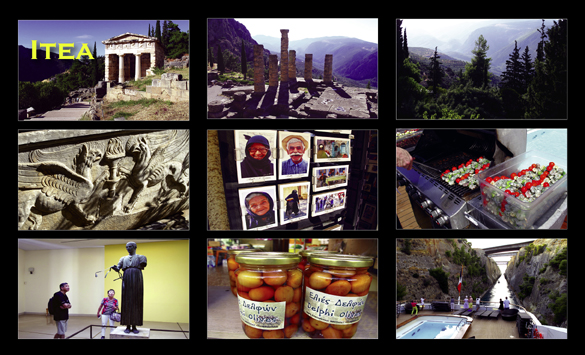
Greece – Delos The Sanctuary of Apollo
With zero habitants and very little shade, the bright and tiny island of Delos – meaning ‘brilliant’ – has long been considered as one of the most important mythological, historical and archaeological sites in Greece. The island was once a thriving port and by 100 BC it had become the financial and trading center of the Mediterranean, and filled with marble statues and temples representing various Greek Gods, while the population rose to 30,000 as workers and families flocked from Rome, Egypt and Syria, establishing a harmonious culture for many years before several attacks and invasions practically wiped out the population.
After many attempts to protect and stabilize life on the Island, Delos became uninhabited by the 18th century, a state in which it remains today – however it’s intrigue and historical importance are reason enough to visit. Upon arrival, Agora of the Competialists (150 BC) is normally the first ruins travelers encounter. Meaning ‘the gathering place’, this open yard is where locals and market traders haggled at the stores set up by Roman citizens and newly free slaves. At the center of the square remain two large shrines, built and dedicated to Hermes and his mother Maia.
To the left of the Agora one can find the Sacred Way, which leads to The Sanctuary of Apollo. The paved road is still dotted with marble bases that once housed the statues given to the island by local kings and generals. Whilst little remains of the three great temples which make up the Sanctuary of Apollo, it is still the most important site for visitors today.
More inland, I browsed through a selection of impressive artifacts and various statues at the site museum, which includes the several statues of Artemis which were found in the Temple of Artemis, to be found on the north of the sanctuary.
As the island of Delos covers just 5 sq. km, it can certainly be explored in an afternoon or morning stop over. We spent the morning here before the short 2 km boat trip to the queen of the Cyclades.
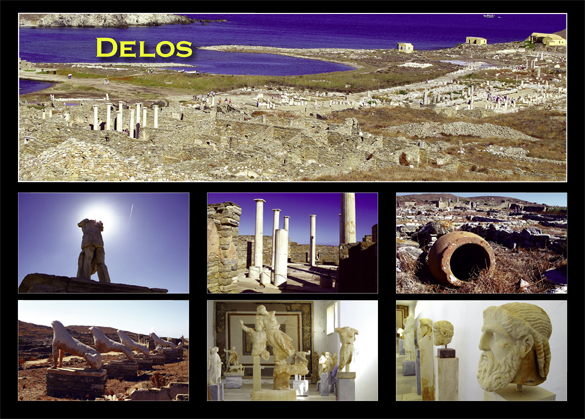
Greece – Mykonos The Heart of the Cyclades
IWith its white mills and quaint little port where boats bob lazily at the foot of the terraces, Mykonos never fails to inspire. Upon arrival I could swear I was looking at a classic postcard from Greece. After wandering the island’s labyrinth of whitewashed alleyways I was surprised by many things on an island that is famed for its nightlife. While the center of the main town – also called Mykonos – can be loud at night, the majority of the island is sleepy and romantic. One of the most romantic spots is the colorful “Little Venice” district where the houses are built right on the sea giving it a special ambiance – it’s also known as one of the best sunset spots on the city. Let yourself be tempted by the numerous taverns which line its seafront opposite the old port.
I headed up to the looming windmills which can be seen peering over the lower hills upon arrival. Along with the typical architecture they are one of the most recognized images of Mykonos, and were more impressive than I imagined up close with their well-preserved ice white coating. Built in the 16th century, the windmills have been an iconic image of Mykonos ever since due to the islands year round wind combined with its ideal location. Their importance however did begin to decline with the improvements in technology since the First World War. From here you can also take in a beautiful view of Little Venice.
I just about made it to Archaeological Museum of Mykonos before it closed, which houses an impressive collection of everyday items from 25th-1st century BC, before exploring the nearby Mykonos Town Hall.
Away from the island’s main town, Ano Mera Village is worth a visit and is located 8 km from Mykonos town. Ano Mera is the most populated town on the island and offers an authentic experience of life on this enchanting island. Locals take their time arriving to work; local bakers catch up with friends on the street corner whilst office workers discuss the latest news with taxi drivers who are in no rush to drive off for their next ride.
I opted for Sunset at Paraportiani, avoiding the crowds at Little Venice and taking a more private view form one of the most photographed spots on the island. Mykonos is an island to salver, to sit back and enjoy, to people watch and to feel the island life from the local’s point of view.
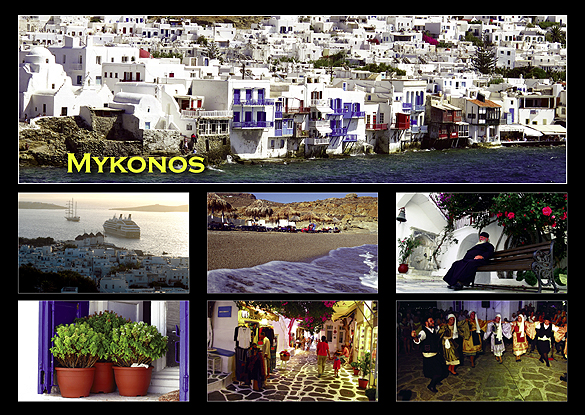
Turkey – Dikili Natural Beauty and History
A small and peaceful port on the shores of the Aegean, Dikili has retained its picturesque charm. The town’s center is lined with pine trees, old cobbled streets and cute restaurants, bars and tea shops, whilst children playing on the rough beaches have seemingly more space to wander than they would in the more touristy parts of the country. A hot spot for Turks looking for a quiet vacation spot, yet still relatively undiscovered by the masses, Dikili is beginning to grow fast; apartment buildings are rising out of the hills while boutique hotels and villas are becoming popular business.
In and around the town Dikili shares an intense mix of natural beauty and history. A simple drive around the town’s outskirts offers breathtaking views unrivaled throughout the country. The nearby thermal springs are a great draw along with the Crater Lake in Merdivenli village, while the unexplored site of Atarneus offers potential ancient findings dating back to prehistory.
From here we head out to explore Pergamum, one of Turkey’s finest archaeological sites, not just because of the many and varied ruins but also for its splendid hilltop location. At one time a serious rival to Athens, Alexandria and Rome, Pergamum’s library was the second largest in the ancient world and offers visitors the rich heritage of its architecture in an intimate setting. The Book of Revelation mentions Pergamum as housing the Throne of Satan, and the city it once was, was regarded as one of the eeriest cities in the Roman Empire.
Back in the center of town, a stop off the Merkez Mosque is worth the visit, and offers the chance to see a scarce example of wooden architecture dating back to the 1700s.
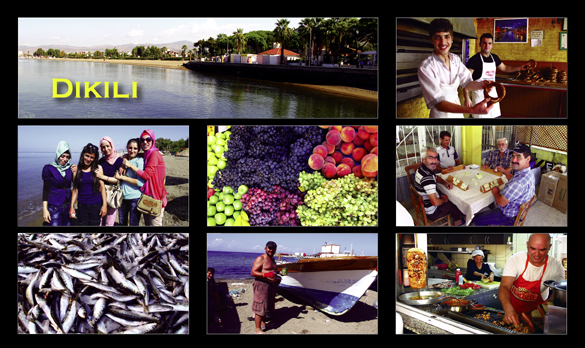
Turkey – Istanbul the Crossroads of Europe and Asia
The crossroads between Europe and Asia, where east meets west; Istanbul’s location between the continents spawns new nicknames on a seemingly annual basis. We finished our cruise here, which only led to another adventure that very few cities can offer. Istanbul is just one of the many sides to Turkey, and goes against the grain to what can be expected in most parts of the country. After a relaxing cruise I knew traveler within me would want something to sink its teeth into, and a few days in Istanbul provided the perfect finish.
Whilst the capital status belongs to Ankara, Istanbul is Turkey’s largest city and also one of the world’s largest based on both size and population, with around 14 million people residing here. The sounds of mopeds and scooters battling with the frustrated traffic is a 24 hour affair, the smells of herbs and spices being cooked up on the streets and in the bazaars sizzles through the night and the people work hard yet party even harder as socializing and family outings are common sites amongst the locals. New York has the nickname of the city that doesn’t sleep, despite the fact that most establishments are closed at 2:00am. At 2:00am in Istanbul the night is still young, if it even ages. Istanbul quite simply doesn’t sleep.
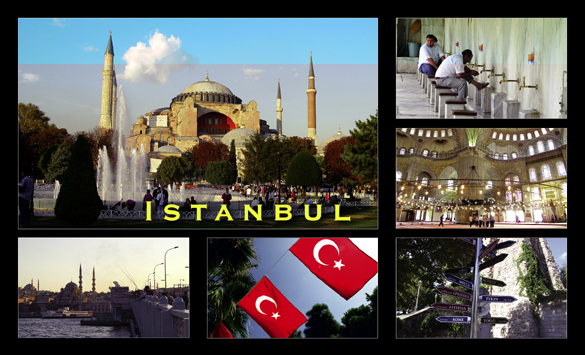
A brief description of Istanbul could leave many observers pondering. In a city so crowded, how is the safety? Hygiene? Crime? All of these points spring to mind when a booming metropolis catches the eye. It is safe to say that Turkey’s largest city is an exception to the rule. Istanbul is filled with people all day and all night, that’s for sure. The people however are amongst the many bright spots this city has to offer. With a thirst for a happy life, quality service, family and friend’s time and plain old talking, the people of Istanbul embrace and give back, and a sociable tourist can find himself swapping contacts details several times during a short trip.
We stayed at the Premist Hotel in Old Istanbul, which proved to be a perfect location and close to almost everything in the city. We were greeted by immaculately dressed porters and soothing mannerisms which dissolve the heat and the outside world. After studying the city beforehand I decided that once rested, I wanted to head straight to Hagia Sophia, also known as the Church of the Holy Wisdom, and acknowledged worldwide as one of the world’s truly great buildings. Rebuilt between 532 and 537 after a destruction and fire destroyed the original two respectively, Hagia Sophia originally dates back to the 4th century, and is regarded as one of the best remaining examples of Byzantine architecture found today.
The churches principle dome is held on pendentives:, each of which is intricately decorated. The domes incredible weight goes through the pendentives and onto four huge piers at each corner, which allows for the dome to seemingly float on top of the four arches. Hagia Sophia is an inspiring place which one could visit time and time again to immerse themselves in the history of the changes the structure has endured.
Heading across the park to the nearby Sultan Ahmed Mosque, more commonly albeit unofficially known as the Blue Mosque, Istanbul offers another view of the city’s grand history. It was built to rival the Hagia Sophia, and its blue tiles from which the mosque gained its unofficial name sharply contrast against the white marble, whilst the blue tips of the six minarets stand out above and beyond, piercing the clouds. The buildings inch perfect proportions can be viewed from inside the courtyard when entering from the Hippodrome. The interior is arguably overshadowed by that of Hagia Sophia, however the tinted windows do create a wonderful effect throughout the room while the tiles that run along the walls are one of the standout points from the inside.

For those looking to delve deeper into Istanbul’s intriguing history, look no further than Topkapi Palace museum, which was home to the Ottoman Sultans for 400 years. Here you can view the magnificent courtyards – two of which were exclusive to royalty and VIP’s only – and learn of the endless and balmy stories that surrounded the rulers. The Istanbul Archaeology Museum which sits behind Topkapi Palace can – and should – be visited on the same day. Around three to five hours is sufficient to cover the two depending on your interests. The Archaeology Museum is three museums in one complex: The Archaeological Museum (in the main building), the Museum of the Ancient Orient and the Museum of Islamic Art. All three are worth your time and we spent a few hours exploring the vast array of of Turkish, Hellenistic and Roman artifacts, including Glazed tile images from the Ishtar Gate of Babylon, 800,000 Ottoman coins, seals, decorations and medals, as well as the Statue of Alexander the Great.
Those going to Turkey will no doubt have heard of the famous Turkish Delight, a sweet treat which is made by mixing honey and grape molasses together with some little flour, beet sugar and also starch, to create a soft jelly like texture which is covered in various shells including walnuts, pistachio and coconut. We headed to the oldest Turkish Delight maker in the city, Haci Bekir, who have been producing the famous sweet for 5 generations since 1777. The store is still in the exact location and building it was when Bekir Affendi opened the doors over two hundred years ago. Here one can not only buy and taste this local treat, but also learn how to make it. Whlst my efforts didn’t match that of the experts, we came away with great memories, souvenirs for the family and a sugar hit to help us march on through this wonderful city.
We rounded off a long day with a wonderful meal in the Fenerbahce district of the city. With fantastic views along the marina we encountered Divan restaurant, one of Istanbul’s most highly regarded restaurants. Offering fine international cuisine and well renowned for its service, it’s difficult to find a disappointed punter in the house, as Divan serves up nothing less than the freshest produce and arguable the best restaurant view in the city.
A late night stroll around the very touristy but nevertheless entertaining Taksim Square didn’t disappoint, which is a huge plaza surrounded by shops, bars and restaurants and hotels. The square is a popular location for public celebrations and events like New Year’s Eve, and is near to the second oldest subway line in the world after the London Underground.
With little time remaining, and after finishing up by visiting the Grand Bazaar, strolling the magnificent Istiklal pedestrian street and eating ate at the under the bridge restaurants at the lively harbor, we went off the beaten track and headed to the Asian side of Istanbul, which unfortunately doesn’t receive the touristic attention the European side, but is littered with delights of its own. Start with a pick-me-up at the famous coffee shop at Moda pier, which overlooks the Marmara Sea before exploring the nearby Kadıköy Daily Market which offers local fresh produce, handicrafts and a row of books stores and pastry shops. For those who enjoy a photo opportunity, head to the harbor where you can find magnificent views of the city.
After a rollercoaster ride around the city of two continents, we were taken by limousine back to airport by our package providers TravelXclusive, whose professionalism and attentive personal care made both the planning and exploring of Istanbul all the more memorable, and ensured that this visit to the old city certainly won’t be the last.
Air France has daily flights to Istanbul from Paris and departures from major Canadian cities. Air France and the SkyTeam Alliance offer 15,000 daily flights to 1,024 destinations in 178 countries and connections from the best hubs in the world. www.airfrance.com
